The surviving copy is a Blue Ribbon reissue from October 11, 1947.
The original title card has surfaced, and shows no director credit, as is typical for a Leon Schlesinger production released after a director quit or was fired.
You can see a good-quality (tho' time-compressed) version of this cartoon HERE. No DVD or Blu-Ray release of this cartoon yet exists.


















<><><><>
A pretty good (and mostly mute) predator/prey comedy, The Cagey Canary feels more like a Friz Freleng cartoon than Avery's work. Freleng would soon release a similar cartoon, Double Chaser, as he worked his way toward Tweetie Pie, his Oscar-winning 1947 classic. If the credits of this original title card are at all reliable, Michael Maltese provided the story for this short. Its tit-for-tat humor, variations on a central (and threatening) action and what dialogue it has syncs up to Maltese's work with Freleng. It's less talky than Maltese's writing for Chuck Jones, but its structure and its character dynamics are accomplished.
Maltese filtered through the detached chess-match of Avery's comedic eye, it again shows how close these late Schlesinger cartoons approach the look and feel of Avery's M-G-M classics. His drawing style is still buried deep within Robert McKimson's character designs. With their tendency towards better animation, the added bells and whistles slow Avery's timing down--with one gag taking a hell of a long time to get across. Let's wade in and have a look-see...
We fade in on an elaborate cycle of violent cat-canary combat:
Proto-Granny walks in, is shocked.
As cartoon traditions demand, this will result in an ultimatum.
But first, some feline abuse with the ultimate weapon--rolled-up newspaper.
Cat's mega-streak to the floor is too fast to grab in full.
Granny coos to the unfazed canary--the character in this short that reveals some of Avery's drawing style.Some fine drawing and posing in this two-shot of Granny and Cagey.
Cat will be given heave-ho into the unholy night if one more spat occurs.
It's raining...well, you know...out there. The outside shot is a little gem of atmosphere.
Cat does extended "uh-uh" head-shake--in a scene that presages Frank Tashlin's '40s look.Granny condomizes cage, wishes Cagey sweet dreams...
...and out goes the light, setting the stage for mayhem.
No running commentary is required here. Let the poses and sublime body language tell it.
This is such fluent and intelligent animation. One has to remember that it's only been four or five years since the late-Deco, pie-eyed and over-symmetrical animation of the early Avery cartoons. There is no longer awkwardness or uncertainty in design or execution. The mutable quality of this work was a quantum leap.On comes the light, the better to see malfeasance with...
Cat's eyes ooze up over table edge; rest of head slides into place.
Such perfect facial expressions in this sequence.
A reprise of the Bugs Bunny finger-stroll.
Terrific shock value in the timing here. We know it's coming, but Avery pits our anticipation against itself--and we take the bait.
This happens at top speed--faster, in fact, than the first year or two of Avery's M-G-M cartoons, where all that high-falutin' animation slowed him down.Bird gives us the tacit "I'm gonna lay it on thick" nod.
Zero dialog allows Avery, Stalling and his animators to do wonderful work. No commentary is required here, save to note some of the great rubbery distortions and the wildest takes Avery has so far attempted.
The plasticity of the cat's body--the way it conforms to the right angles of the furniture--is marvelous, and suggests stealthiness in a tactile way.Movement of home duly noted by bird.
Cat's expression of smug self-satisfaction seems to forecast many a similar mug on many a similar Chuck Jones character in years to come.One can see the future of Avery cartoons in the ritualized efforts of the cat. I'm reminded of 1949's The Counterfeir Cat, '51's Cock-A-Doodle Dog and '52's Magical Maestro and Rock-a-Bye Bear. It's a comedy of futility similar to Chuck Jones', but more mechanized and stripped of emotion. You can't feel for Avery's characters, as you do for Wile E. Coyote or the wolf in the wolf and sheepdog cartoons. Their streamlined try/fails are bracingly funny, and the obsession in the face of overwhelming odds against them brings a comic gravity to the table that no other cartoon auteur could approach.
Some Clampett-esque distortion in this scene suggests that this scene might not have been fully mapped out by Avery before his walk-out. The rubbery comedy of the cat's grimaces and salivations has a lot more in common with Clampett's comedic world than Avery's.
Fly trouble.






By now, the ritual of feigning innocence has replaced the cat's hunting game. The only thing that matters is getting back to that rug in time and not waking ur-Granny.
Canary uses a curious side-street of Cartoon Logic: that a mammal is excited by sexy pictures of any other mammal, species be damned. It works to the cat's disadvantage, of course.




Here we see a unique Avery/Clampett hybrid--a fusion of two different filmmakers' version of the same raw emotion. These extremes are to be savored.

In a clever bit that doesn't need to be here, but is delightful, impact of pin-up girl affects another life-form. Canary remains immune to curvaceous charms.




Meanwhile, elsewhere on the floor, the cat seethes with self-disgust, The day's events have not turned out well.



Idea!














Dissolve to scheme-in-progress, which is a ploy seen in at least one early Hanna-Barbera Tom and Jerry cartoon. It's probably of older vintage than that.



Perceived truce leads to high-stakes betrayal.
Whistling is of no avail, although the spray of saliva-infused cracker crumbs seems to smack of Clampett's hand. He was a fan of characters eating sloppily and the gross-out factor therein.
Cornered!
Ouch! And just in time...





The cat's OCD ritual plays out again, but the canary now feels empowered to really harass its feline foe. The bird's got the cat's number. Though in theory he'd like to gobble up the canary, he values his life of indoor luxury most, and is resigned to letting go of the idea. Only now can the supposed prey begin to razz its opponent to the max.
A new rhythm is born. Bird, in safety of cage, heckles cat, then does a fly-by physical hassle, and back to its safety zone. It's done with remarkable timing. The only thing that slows Avery down in these final WB cartoons is his tendency to dawdle during transitional moments. At M-G-M, he'll strip those necessary-but-cumbersome intervals to the bone, to be betterment of his comedic vision.
Humiliation #1.
Back to cage.



And we dissolve to the next potential crisis...
This shot is really Clampett-y.
Dissolve to new deal.
Three rounds of chase-and-whistle...
You just know there's an ironing board behind that door.
Yup. Bonus points for not showing the collision...
The faint overlaid stars and planets FX are haunting,
Plenty of motion going towards the camera in this cartoon.
Second collision is another bonus.
Won't get fooled again!
Clampett's hand is overabundant in the rubbery, scruffly exaggerations of this shot.
Well, that's that.

Humiliation #2:
A priceless facial expression below.Nothing can ever make this tongue-as-window-shade gag funny, but all parties involved get at least a B for the jaggedy drawing of the cat-in-shock.
I won't repeat the sequence with the bird flying back to his cage, razzing the cat, then flying down again because Blogger is such a sorry, degraded mess. See footnote at end of post.
Humiliation #3, with mallet:Here is a deviation from the Schlesinger norm--the sudden appearance of the mallet, and its ability to swell in size on impact. There's no leading up to it, no building its presence. It's just there. Wham.
This scene is an example of the sluggish interstitial moment that Avery would soon abolish from his work. His realization that he could jump from Point A to C, D, or L was the thing that perfected his vision of comedic timing. It is the ingredient that makes his cartoons like no one else's, and that almost no other cartoon director understood and used with grace or precision.
Avery would re-use this concept in his 1947 classic, Slap Happy Lion.


Finally! What makes this scene funny and fascinating is that the cat does nothing. He savors the bird's oblivious cocky attitude and takes his sweet time attempting to turn the tables.
And here is a full-on classic Tex Avery take, worthy of any similar moment in the M-G-M cartoons:
Cat goes ass-over-teakettle as he and the bird return to ground zero.
In a clever touch, the cat slides across the polished floor, holding a pose of high rancor.And we dissolve to the next potential crisis...
This scene is another example of how bogged down in a moment Avery still let himself be at Schlesinger's. Five years later, this would be accomplished in three quick shots.
Cut to a shot or two that look like Clampett laid them out and posed the characters.
The spinster's snore-whistling of "Pop Goes the Weasel" is amusing.This shot is really Clampett-y.
And then, in this cartoon's greatest moment, the cat vanishes. It's so unexpected and such an innovative move I'm surprised Avery never attempted it again.
When the cat re-appears outside the room, it just kills.
Pleased, cat gives us the high sign.Dissolve to new deal.
This shot looks so close to the M-G-M stuff it's almost chilling.
Social formalities are severed.Three rounds of chase-and-whistle...
...and the bird unleashed every sonic trick in its bag to rouse the crone.
The next shot is Avery the chess player showing his hand in another moment unique in his career. This removed overhead shot, laid out like an interior decorator's plans, reduces cat and bird to stylized pawns careening through a set course. This is the chase cartoon streamlined down to its bones, and it's a moment of genius.
Back to regular view...You just know there's an ironing board behind that door.
Yup. Bonus points for not showing the collision...
The faint overlaid stars and planets FX are haunting,
Plenty of motion going towards the camera in this cartoon.
Second collision is another bonus.
Won't get fooled again!
Clampett's hand is overabundant in the rubbery, scruffly exaggerations of this shot.
Well, that's that.
It seems that, once a director had left the Schlesinger premises, production was pushed through on their leftover cartoons without much TLC. Note the second cel of the canary under the first one. It only registers as a phantom blip when seen at full speed.
Again, there is much Clampettness in this shot.
These hybrid two-director takes are fascinating.
Bye bye bird.
Rainy night in all its atmospheric misery...
...as warmth is shut off to predator and prey.
United by misfortune, their score is settled. Canary addresses the audience...
Anyone out there interested in adopting two combative pets?
These hybrid two-director takes are fascinating.
Bye bye bird.
Rainy night in all its atmospheric misery...
...as warmth is shut off to predator and prey.
United by misfortune, their score is settled. Canary addresses the audience...
Anyone out there interested in adopting two combative pets?
<><><>
More of a hybrid than Wabbit Twouble, The Cagey Canary impresses with its compact, stylized approach. Since we have no documents that explain where Avery's abandoned cartoons were at, development-wise, at the time of his walkout, we have only the visual evidence of the films. Cagey Canary is a rare blend of Tex Avery's narrative concepts (the ritual action that becomes each character's reason for being; the idea of a formalized, detached chase cartoon; asides to the audience) and Bob Clampett's more aggressive, flowery visual tendencies.
Shots that appear clearly staged and designed by Avery ping-pong between scenes with a distinct Clampett bias. Of course, scenes were laid out and worked on out of order, depending on who was available and what needed doing. The flitting between directorial styles gives Cagey Canary a fascinating veneer in a serviceable one-off cartoon. Had Avery completed it in full, it might rate a "meh." Had Clampett done it from scratch, it would lose its cool and be louder, brighter and perhaps funnier. This Frankensteining of styles and approaches, as directors succeeded directors, is one fascinating facet of the Warner Brothers cartoons.
NEXT TO LAST POST: Aloha Hooey,
<><><>
I must state how terrible Blogger has become since Google sold it to the half-assed fools who now run it. It barely works, and I've had to insert each photograph one at a time, and it requires six clicks per picture, every time. Then, each image must be re-sized--another four mouse clicks.
If I upload any quantity of photos, they appear in the reverse order that I desire. I am glad only two posts remain for this blog, and should I continue this folly, it will be on Wordpress. Blogger, your day has come and gone.
If I upload any quantity of photos, they appear in the reverse order that I desire. I am glad only two posts remain for this blog, and should I continue this folly, it will be on Wordpress. Blogger, your day has come and gone.












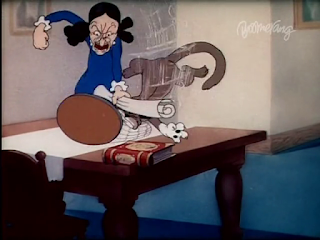




















































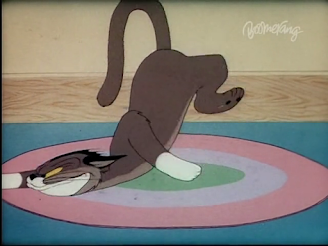


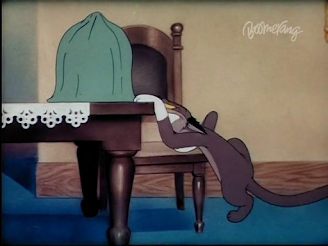


















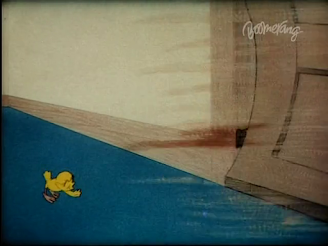
















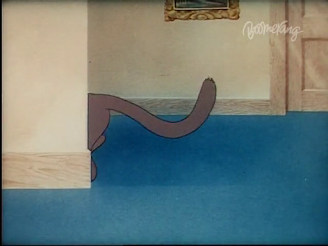




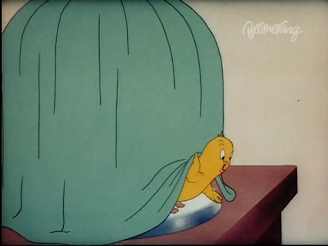
































































































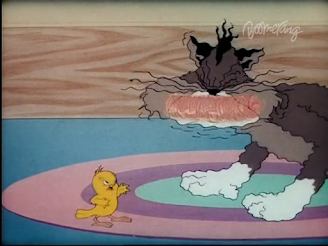


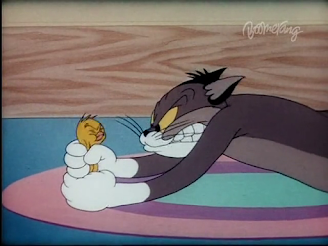













































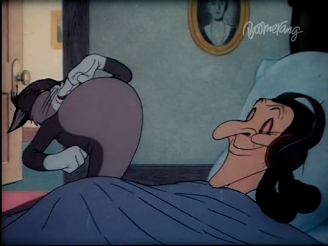
























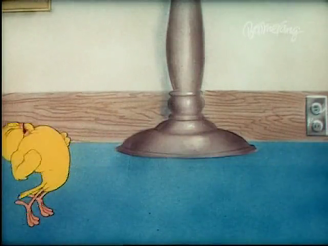

































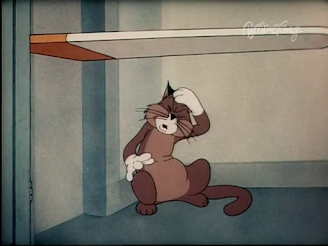















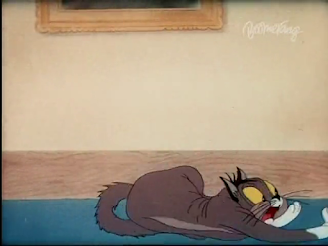


































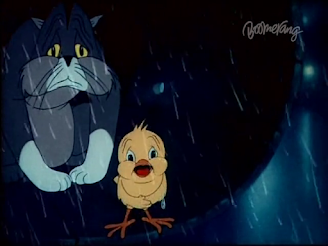




I agree with you about blogger. This new update is really bad. Also here is a non-time compressed copy of The Cagey Canary https://www.dailymotion.com/video/x3ndlf
ReplyDeleteThe short itself was released in France as a part of "Tweety and Sylvester" DVD with its 1995 Turner print. However, the copy was taken from France 3 Television airings, which used to air this short with subtitles.
DeleteI could wait with the review till the following week or weeks, as "The Cagey Canary" is one of the shorts that may appear remastered on HBO Max.
Yes! What wonderful news about these restorations. At long last! And this print already looks lovely, so I imagine the restoration will be stellar!
DeleteI found a picture of the restoration a while ago, this is what it looks like - https://vignette.wikia.nocookie.net/looneytunes/images/c/c8/CageyRESTOREDBIG.jpeg/revision/latest?cb=20200808034057
Delete"Hiss and Make Up", a Freling-Maltese collaboration from 1943, feels like the sequel to this short, where Mike adds an extra character to create a cat vs. dog vs. (eventually) canary situation. As with the ending here, the two main protagonists get tossed from the house by granny, though the bird ends up in a far worse situation after unwillingly leaving the home here.
ReplyDeleteThe cat's shocked reactions here mimic Avery's takes for Bugs' shock at seeing the multiple Cecil Turtles in "Tortoise Beats Hare", while Tex did have Willoughby flowing freely with the spittle in "Crackpot Quail". But the bird's 'takes' at the end when he knows the jig's up with granny (who facially looks like she came out of a 1934 Ub Iwerks cartoon) definitely have a Clampett-Scribner look to them. If nothing else, it's an interesting pantomime cartoon from two directors probably known for the loudest and most frantic cartoons of the Golden Age.
Despite the attribution to Avery and Clampett, the situation (as would later be perfected in shorts like Rock-A-Bye Bear and Deputy Droopy), character designs, and wild takes have always felt more Avery than Clampett.
ReplyDeleteRod Scribner's animation in this short does foreshadow what was to come when Clampett took over Avery's unit.
I reckon that the inspiration for Tweety possibly came to Clampett when he was finishing this short.
It bears noting that the crackers gag was done in a moderately similar fashion in Avery's 1937 short "Ain't We Got Fun." You noted (correctly) in your analysis of that cartoon that eating crackers never seems to have a good end. (http://texaveryatwb.blogspot.com/2014/04/a-tex-avery-terrytoon-almost-aint-we.html)
ReplyDeleteThe movie is in this french DVD boxeset right in the first position of the first DVD :
ReplyDeletehttps://fr.shopping.rakuten.com/offer/buy/69240286/Titi-Et-Grosminet---Coffret---Edition-Limitee-DVD-Zone-2.html?bbaid=6846895028&t=10059824&ptnrid=pt%7C976949973012%7Cc%7C471223205492%7C69240286
Problem : it is hardsubbed in french... It is the only DVD in the world who contains "the cagey canary".
I love this old cartoon, it's always on Facebook for some reason haha. The design of the cat kinda reminds me of Tom (from Tom and Jerry) for some reason I don't know why.
ReplyDelete